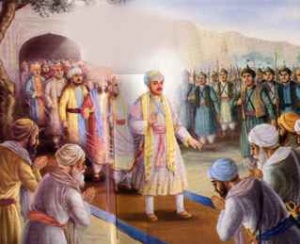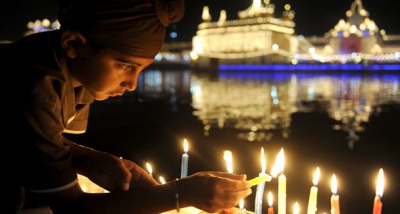Diwali
Diwali or Dīpĝvali is a significant festival in Hinduism, Sikhism, and Jainism. It is also popularly known as the Festival of Lights.
Significance in Sikhism
Bandi Chhorh Divas
Sikhs celebrate Diwali after celebration of Bandi Chhorh Divas.
Sikhs celebrate Bandi Chhorh Divas to mark the return of the Sixth Guru, Guru Hargobind Ji, who was freed from imprisonment and also managed to release 52 Hindu Kings (political prisoners) at the same time from the famous fort of Gwalior by making clever use of Emperor Jahangir's orders to allow any who could hold on to the Gurus coat tails to leave the fort with the Guru (October, 1619).
And so the Kings/rajahs were freed and the Guru became known popularly as the "Bandi Chhor" (Deliverer from prison). He arrived at Amritsar on the Diwali day and the HarMandar (also known as the "Golden Temple") was lit with hundreds of lamps to celebrate his return and hence the day came to be known as the "Bandi Chhor Divas" (the day of freedom).
Martyrdom of Bhai Mani Singh Ji
- Main article: Bhai Mani Singh
(from wikipedia) An important Sikh event associated with Diwali is the martyrdom of the elderly Sikh scholar and strategist Bhai Mani Singh in 1737. Bhai Mani Singh was the Granthi (keeper/reader of Sikh scripture) of Harmandir Sahib (popularly known as the Golden Temple). He transcribed the final version of Guru Granth Sahib dictated to him by Guru Gobind Singh in 1704.
Bhai Mani Singh assumed charge of Harmandir Sahib's management in 1708. In 1737, he received permission from Zakariya Khan, the then Mughal governor of Punjab, to hold a religious gathering of the Khalsa for celebrating Bandi Chhorh Diwas on the auspicious day of Diwali for a large tax of 5000 Rupees. He expected to put together the required sum from contribution made by the Sikhs who would assemble that day. But on discovered Zakariya Khan's plot to kill the Sikhs during the gathering, he sent out messages warning them not to turn up for the meeting. As a result the tax could not be paid and Zakariya Khan ordered Bhai Mani Singh's execution at Lahore.
Ever since the Bandi Chhorh Diwas celebrated during Diwali is also commemorated the martyrdom of Bhai Mani Singh. It is also believed that this event along with other Sikh martyrdoms gave further momentum to the Khalsa struggle for freedom and eventual success in establishing the Khalsa rule in the north of Delhi.
Uprising against the Mughal Empire
(from wikipedia) The festival of Diwali became the second most important day after the Baisakhi, when Khalsa was formally established by the Tenth Guru Gobind Singh in 1699.
The Sikh struggle against Mughal Empire's atrocities on non-Muslims, especially on Sikhs, which intensified in the 18th century, came to be centered around this day. After the execution of Banda Bahadur in 1716, who had led the agrarian uprising in Punjab, the Sikhs started the tradition of deciding matters concerning the community at the biennial meetings which took place at Amritsar on the first of Baisakh and at Diwali. These assemblies were known as the Sarbat Khalsa and a resolution passed by it became a gurmata (decree of the Guru).
Diwali is celebrated by Sikhs because Guru Hargobind returned to Amritsar after his imprisonment at Gwalior where he also won the freedom of 52 innocent Princes who had long been imprisoned at Gwakior for political reasons.
Bhai Gurdas narrated the whole story telling us what happened: Guru Hargobind, the sixth Guru, had been arrested for political reasons. The Mughal Emperor now decided that the religious fundamentalists that had been behind the martyrdom of the fifth Guru, Guru Arjun, were a greater threat to his throne.The Mughal Emperor, therefore, offered to free Guru Hargobind but Guru Hargobind refused to take his freedom until 52 princes who had also been detained for political reasons were also freed.The Emperor offered that all those who could hold the Guru's cloak could go free. 52 tassles were attached to the Guru's cloak and holding to his cloak all the 52 princes went free.
In addition to Nagar keertan (a street procession) and an Akhand paath (a continuous reading of Guru Granth Sahib), Diwali is celebrated by an awesome fireworks display. The Golden Temple as well as the whole complex is festooned with thousands of shimmering lights, creating a unique jewelbox effect.
| Vaars Bhai Gurdaas on Pannaa 19 |
| dheevaalee dhee raath dheevae baaleeani Lamps are lighted in the night of divali festival;
fulaa(n) dhee baagaath chun chun chaaleeani theerathh jaathee jaath nain nihaaleeani har cha(n)dhuree jhaath vasaae ouchaaleeani guramukh sukhafal dhaath shabadh samhaaleean a |
Significance in Hinduism
The story of Diwali is the festival of lights when, according to Indian lore, Lord Rama returned home after destroying the demon god Ravana who had taken away Rama’s wife, Sita.
See Also
References
This Shabad is by Bhai Gurdas Ji: www.sikhitothemax.com


